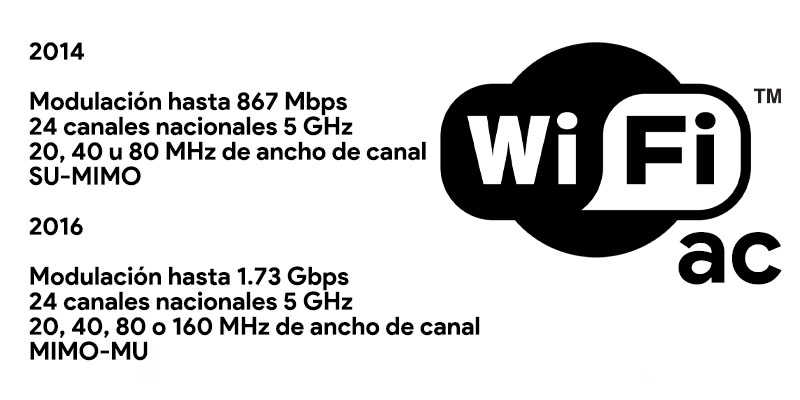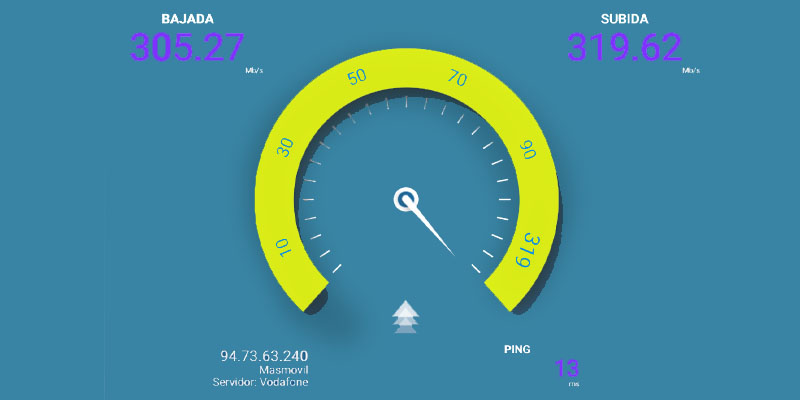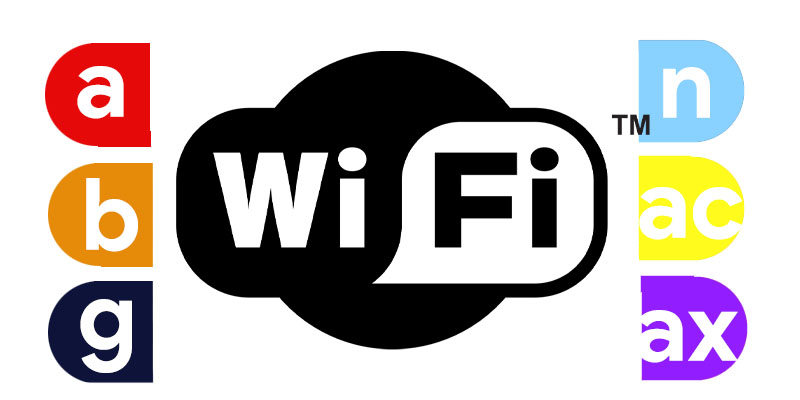
Index:
UPDATED ✅ Want to know what Wi-Fi AC IEEE 802.11ac is and how it beats previous generations? ⭐ ENTER HERE ⭐ and discover everything ✅ EASY and FAST ✅
Wireless communication is increasingly in demand. We are used to doing everything quickly and anywhere, we don’t like ties and patience is something that has gone down in history.
However, in terms of technology we can refer to communicate, cable will always be king, right? WiFi is a form of wireless communication that we often use, but it doesn’t offer everything that a good wired connection does, until now.
However, this resource is not inflexible. There are different standardseach with its own characteristics, and we are already approaching a connection full of benefits without the need for cables. Do you want to know what WiFi AC is? You will discover it all in this text.
What is WiFi AC and what is this new network connection standard for?

WiFi AC, WiFi 5, WIFi Gigabit or IEEE 802.11ac is a 2014 communication standard that improves the IEEE 802.11n standard.
This supposes an improvement of the data transfer, which reaches, in optimal conditions, the 433Mbits per second and that it would achieve, therefore, up to 1.3 Gbits per second using a triple antenna. The sending of data is directional.
Know that this standard It includesbeing built on WiFi N, the advantages of generations b, g and n, that is to say, it is not a different product but rather expanded or improved with respect to the previous ones. This implies that, if you have devices compatible with IEEE 802.11ac, it does not make sense to use the standards prior to this because they are already included in it.
We are not talking, therefore, about the characteristics of a network but about the form of communication between devices who make use of it. For this reason, no matter how good the characteristics and figures are, if the network is not adequate, the WiFi will not be able to offer more than it does.
What we are talking about is the best WiFi that has been launched so far. It is true that it is not the most modern, as there are some later ones. However, this is the one, due to its characteristics and possibilities, it has made a dent and by which manufacturers bet when choosing which standards their devices would be compatible with.
What are the benefits and features of WiFi AC (IEEE 802.11ac)?
Among all that this new standard includes and supposes, We will highlight the following:
increased speed

This is made possible through the use of the 5GHz bandquadrupling, compared to 802.11n, the bandwidth, with up to 160MHz standardized (with a minimum, by law, of 80 MHz).
It is also worth mentioning that it makes use of up to 8 MIMO streams (i.e., from in-out movements of the waves, a highly efficient propagation) as well as modulation from HI or high intensity, to 256QAM (the former is 64 QAM). In addition, you can work with a modulation Multi-user MIMO, downgradeable for four clients at the same time.
This means that, in theory, its speed can be the same as that obtained by cable, it is estimated that up to 12 times higher than the previous version of the IEEE. If you want check your internet connection speed click here.
To understand how these concepts are We can make a comparison that explains a little the role of each one:
- The connection between two devices it would be a tube.
- The MIMO will be extra tubes to be able to move (in both directions) through them more amount of data.
- The bandwidth refers to the size of these tubes.
- The QAM modulation it would be the ability to compact the data to fit more.
Possibility of expansion
Also, this speed still can be enlarged by up to 25%. This is something that operators could achieve offering 1024-QAM modewhich is not standard but it is possible to work with said amplitude modulation to compact the data and allow more to travel in the same period of time and, therefore, a smaller number of them arrive at their destination earlier.
High quality and availability
The fact of offering directionality makes the connection cleaner, since the Obstacles interfere less with the signal.
We also do not suffer from interference or cuts thanks to the fact that the 5 GHz band is used, which is not saturated since most devices still use 2.4 GHz.
Compatibility with many devices
We have already indicated that it is not the latest generation of the wireless communication standard. However, the later ones have not penetrated so much in the market and, for this reason, manufacturers do not usually include them, at least, in devices of a general nature and use.
Yes they do with WiFi AC because of how much they like it. This means that it is very likely that your current devices (or the ones you choose when you renew them) include compatibility with that standard.
What is “Beamforming” in the operation of Wi-Fi 5G?
The beamforming is a technique of signal interpretation that is being launched into a space. With her, appliances couldput it in some way, modify the way it expands for greater reception changing its direction. This means that, if we want to, we can also choose where not to direct it.
If our router includes it, we can modify the emission of the waves. In general, these have a certain intensity that reaches everywhere equally because they expand concentrically. With beamforming we are going to achieve direct the signal to where we are and we are interested.
This is a feature compatible with WiFi AC but this does not mean that any device compatible with this standard includes it. That is up to manufacturers, who decide to include the functionality or not.
Likewise, it is also interesting to know that WiFi N is also compatible with this technique, although there are far fewer devices compatible with it that include it.
How is this wireless better than previous generations or why is it better?
The best way to answer this question is to know what each of the standards that have been released are like in order to compare them at your convenience.

WiFi 802.11 or traditional WiFi
Appears in 1997. Works with direct sequence diffusion spectra (DSSS) or frequency hopping (FHSS), achieving speeds of 1 and 2Mbps for sending raw data. This occurs through three non-overlapping channels, at 2.4 GHz and being these of medical-scientific or industrial frequencies. The width of the channel is 20 MHz.
Wi-Fi 802.11b
In 1999, the WiFi 802.11b standard appears. This keeps the same channels. It changes with respect to the previous one in that different modulations are given for the speed, of 1 and 2 Mbps but, now also, of 5.5 and 11Mbps. We also see that now a high speed direct sequence diffusion spectrum, directly withdrawing the FHSS and improving the DSSS. The width of the channel is maintained.
Wi-Fi 802.11a
The same year a huge leap is made and this generation or version of the standard appears WiFi, which makes it begin to reach the user.
We see velocities modulating at 6, 9, 12, 18, 24, 36, 48 and 54 Mbps. It goes to use 12 national information channels not licensed or superimposed on the 5 GHz. An orthogonal frequency division multiplexing is given, working with 52 subcarrier channels. The channel is maintained.
WiFi 802.11g
This is the version that was launched in 2003. It maintains the data modulation although it can be used, if desired, that of 802.11b, that is, that of 11Mbps with DSSS. It also gives the previous multiplexing, 52 channels, being also compatible with WiFi b. We return to three non-overlapping channels of medical-scientific and industrial frequency, at 2.4GHz. The width of the channel is maintained.
WiFi 802.11n
The speeds modulate in 1, 2, 5.5, 6, 9, 11, 12, 18, 24, 36, 48 or 54 Mbps. can we get one 450Mbps maximum speed. Multiplexing now makes use of multiple inputs and outputs (what we previously called MIMO) as well as channel bonding (or CB). We see both industrial, medical and scientific frequency non-overlapping channels being used at 2.4 GHz and also the 12 unlicensed national information at 5 GHz that already appeared in the WiFi 802.11a. The width of the channel can continue in the 20 MHz although it is also given in 40MHzthe double.
Wi-Fi 802.11ac wave1
This is the version that concerns us, launched in 2014. The speed modulation goes through the 200the 400the 433the 600 and the 867Mbps. Unlicensed non-overlapping national information infrastructure channels are duplicated in 5GHzbecoming 24. We maintain multiplexing with a single MIMO user. Channel width can be 40u 80MHz.
Wi-Fi 802.11ac wave2
Improvement over the previous one, in 2016, which we can now use multi-user MIMOthat is, MIMO-MU and that the width of the channel is doubled, becoming up to 160MHz (we always keep the old ones of 20, 40, and 80). This makes the theoretical maximum speed up to 1.73GHz.
Wi-Fi 802.11ax
Finally, we have what is known as Wi-Fi ax or Wi-Fi 6. In this case we again see a modification of the channels, having both the national information infrastructure, that is, in the 5GHz, and also including again the frequency 2.4GHzThe maximum theoretical speed that is reached, with a channel width of 160MHzIt is 2.4Gbpswhich can be enhanced, depending on the infrastructure, up to almost, attention, 10Gbps.
Is this the best WiFi out there? How fast and stable can it get?
If we consider only the aspects that we have just seenit is evident that 802.11ax Wi-Fi is better. However, not only this should be taken into account, it is also interesting to see what compatibility the market offers with said standard.
The latter we offers more speed than WiFi ac, with 2.4 Gbps compared to 866.7 Mbps clean 802.11ac (We have already seen that with a triple antenna we can multiply the speed). We also see that the MIMO is multi-user and that we can make use of the 2.4 GHz frequency.
So, seen like this, yes, this one is better. But… What good is it to us if we don’t have devices that make use of that standard? You could renew them to enjoy their benefits. However, this is where we have to consider the whole and decide if the improvements over WiFi ac are worth spending a lot of money on compatible devices.
In our opinion, at the moment, wifi ac is still the best optionsince the number of devices on the current market are compatible, having a lot of variety and having a totally accessible price for anyone.
networks